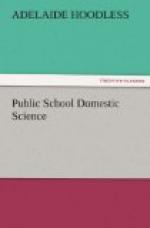------------
“The hydrogen existing in the compound in excess of what is required to form water with the oxygen present is calculated as carbon. It is only necessary to multiply the nitrogen by 6.5 to obtain the amount of dry proteids in 100 grams of the fresh food substance.” (Dujardin-Beauretz.) The following simple rules are given by Parks:—“1st. To obtain the amount of nitrogen in proteid of foods, divide the quantity of food by 6.30. 2nd. To obtain the carbon in fat multiply by 0.79. 3rd. To obtain the carbon in carbohydrate food multiply by 0.444. 4. To obtain the carbon in proteid food multiply by 0.535.”
Finding that our food and our bodies contain essentially the same elements, we must also bear in mind that the body cannot create anything for itself, neither material nor energy; all must be supplied by the food we eat, which is transformed into repair material for the body. Therefore, the object of a course of study dealing with the science of this question, as it relates to the daily life, should be to learn something of how food builds the body, repairs the waste, yields heat and energy, and to teach the principles of food economy in its relation to health and income. This, with the development of executive ability, is all that can be attempted in a primary course.




